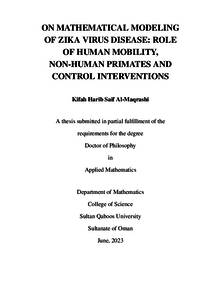Document
On Mathematical modeling of Zika virus disease : role of human mobility, non-human primates and control interventions.
Publisher
Sultan Qaboos University.
Gregorian
2023
Language
English
English abstract
ZIKV has affected many countries around the world, causing a variety of consequences. Several strategies, including awareness campaigns to promote travel safety
to tropical regions, personal protection and vector control, have been implemented to
limit its spread. Mathematical models have been used to better understand the dynamics of Zika and to assess the efficacy of interventions. In this thesis, Zika infection
compartmental models have been developed to investigate various aspects of the dis ease. The first model incorporates human movement between rural areas and nearby
forests, to investigate the role of human movement in the spread of ZIKV infections in
human and mosquito populations. Proportions of both susceptible and infected humans
living in rural areas are assumed to move to nearby forest areas. Direct, indirect, and
vertical transmission routes are incorporated for all populations. The second model
describes the spread of the disease in three interacting populations, namely, human,
vector (mosquitoes), and non-human primate (monkeys) inhabiting forests area. It
aims to investigate the role of non-human primates in the disease transmission dynam ics. Human movement between rural and forest areas has been also considered. It is
assumed that the ZIKV spreads within the non-human primate population, which in
turn acts as a reservoir of infection, and is then transmitted to the human population
through infected mosquitoes. The proposed model incorporates vertical transmission
and direct transmission in all populations. The third model represents a multi-patch
model for the spread of ZIKV infection taking into account direct and indirect transmissions along with vertical transmission. The model is fitted to a data set collected
from two neighboring countries Brazil and Colombia to estimate some of its parameters. The fourth model investigates the transmission dynamics of the co-infection of
Malaria and Zika. The potential interactions between these diseases and their implications for public health and the potential effectiveness of various intervention strategies
have been explored. The analysis of the models include positivity and boundedness of
solutions, derivation of the basic reproduction numbers, existence and stability analysis of the equilibrium points, and bifurcation analysis are performed. Also, sensitivity
analysis of the basic reproduction number to models' parameters has been presented
and discussed. The effect of some model parameters on the disease transmission dynamics has been carried out numerically and presented graphically in each mod
Member of
Resource URL
Arabic abstract
انتشر فيروس زيكا في العديد من البلدان حول العالم ، مما تسبب في مجموعة متنوعة من العواقب. وينتقل الفيروس عبر نوع معين من البعوض وهو بعوض الزاعجة . تم استخدام النماذج الرياضية لفهم ديناميكيات زيكا بشكل أفضل ولتقييم فعالية التدخلات لمكافحة انتشار المرض. في هذه الأطروحة تم تطوير نماذج م ختلفة لعدوى زيكا لدراسة طرق و جوانب مختلفة لاتشار المرض. حيث تم التطرق في النموذج الأول لدراسة تأثير الحركة البشرية بين المناطق الريفية والغابات المجاورة في انتشار عدوى فيروس زيكا بين البشر والبعوض . حيث تم افتراض تنقل و حركة نسب معينة من كل من البشر المعرضين للإصابة والمصابين الذين يعيشون في المناطق الريفية إلى مناطق الغابات القريبة. كذلك تم افتراض طرق انتقال العدوى المباشرة وغير المباشرة والعمودية لجميع السكان. أما النموذج الثاني فقد وصف انتشار المرض في ثلاث مجموعات متفاعلة، وهي الأنسان، الناقل )البعوض(، والرئيسيات غير البشرية )القرود( التي تسكن منطقة الغابات. كما تم دراسة تـأثير الحركة البشرية بين المناطق الريفية والغابات. وفق الدراسات فإن فيروس زيكا ينتشر بين الرئيسيات غير البشرية ، والتي بدورها تعمل كمستودع للعدوى، ثم تنتقل إلى البشر عن طريق البعوض المصاب. يشتمل النموذج المقترح على الأنتقال الرأسي للمجموعة السكانية. في النموذج الثالث تم دراسة انتشار العدوى الفيروس ية لزيكا باستخدام نموذج متعدد الرقعات. مع افتراض طرق العدوى المباشرة وغير المباشرة جنبًا إلى جنب مع الأنتقال الرأسي. تم تحليل النموذج لفهم آلية انتشار المرض. كما تم استخدام مجموعة بيانات حقيقية تم جمعها من دولتين متجاورتي ن (البرازيل وكولومبيا ( لتقدير بعض معامالت النموذج. يبحث النموذج الرابع في ديناميكيات انتقال العدوى المشتركة لمرض المالريا وزيكا. تم دراسة الأثار المترتبة على انتشار هذه الأمراض و تأثيرها على الصحة العامة و استراتيجيات التدخل والتحكم المختلفة. تم تنفيذ العديد من الأستراتيجيات ، بما في ذلك الحماية الشخصية وعلاج الملاريا ومكافحة البعوض الناقل للمرض ، للحد من انتشاره . تم تحليل كل النماذج المقترحة رياضيا عن طريق ايجاد حدود الحلول الموجبة ، وايجاد أرقام التكاثر الأساسية ، وتحليل وجود واستقرار نقاط التوازن، وتحليل التشعب، كما تم عرض ومناقشة تحليل الحساسية لمعاملات كل نموذج. تم أيضا دراسة تأثير بعض معاملات النماذج المقترحة عددياً وعرضها بيانيا.
Category
Theses and Dissertations

